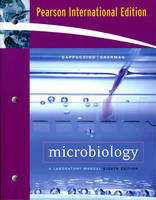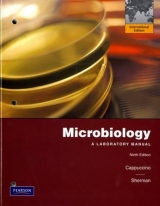
Microbiology
Pearson (Verlag)
978-0-321-48820-6 (ISBN)
- Titel erscheint in neuer Auflage
- Artikel merken
James G. Cappuccino is a retired professor (in residence) of Microbiology from the Department of Biology at the State University of New York at Rockland Community College in Suffern, New York. In 1991, he was the recipient of the Chancellor’s Award from the State University of New York for Excellence in Teaching. He received his M.S degree (1955) and Ph.D (1957) from Rutgers University, New Brunswick, New Jersey. From 1957 to 1970 he was associated with the Sloan Kettering Institute for Cancer Research. He was the author and co-author of numerous papers in the area of cancer chemotherapy, and was a member of the faculty of the Sloan Kettering Division of the Graduate School of Medical Sciences at Cornell University in New York, where he taught microbiology. From 1970 to 1995 he taught microbiology, parasitology and clinical chemistry at SUNY Rockland. He is an emeritus member of the American Society for Microbiology (ASM) and an emeritus member of the American Society for Cancer Research (AACR). Although officially retired, he still teaches a microbiology course for nurses at SUNY Rockland. When not writing, he enjoys spending time with his wife Elaine and their family at their summer home at the New Jersey shore. He also enjoys theater, literature, traveling abroad, and the quiet hours in his wood working shop. Natalie Sherman received her B.S. in biology and her M.S. in microbiology from Fairleigh Dickinson University. Her professional career spanned 32 years at the State University of New York at Rockland Community College in Suffern, New York, as a professor of microbiology. In addition to microbiology, she taught genetics, anatomy and physiology, and human sexuality. To be more akin to the needs of her students she received an AAS degree in Nursing in 1981. She passed away on October 29, 2001.
Part 1: Basic Laboratory Techniques for Isolation, Cultivation, and Cultural Characterization of Microorganisms
1. Culture Transfer Techniques
2. Techniques for Isolation of Pure Cultures
3. Cultural Characteristics of Microorganisms
Part 2: Microscopy
4. Microscopic Examination of Stained Cell Preparations
5. Microscopic Examination of Living Microorganisms Using a Hanging-Drop Preparation or a Wet Mount
6. The Microscopic Measurement of Microorganisms
7. Darkfield Microscopy
Part 3: Bacterial Staining
8. Preparation of Bacterial Smears
9. Simple Staining
10. Negative Staining
11. Gram Stain
12. Acid-Fast Stain (Ziehl-Neelsen Method)
13. Differential Staining for Visualization of Bacterial Cell Structures
Part 4: Cultivation of Microorganisms: Nutritional and Physical Requirements, and Enumeration of Microbial Poulations
14. Nutritional Requirements: Media for the Routine Cultivation of Bacteria
15. Use of Differential and Selective Media
16. Physical Factors: Temperature
17. Physical Factors: pH of the Extracellular Environment
18. Physical Factors: Atmospheric Oxygen Requirements
19. Techniques for the Cultivation of Anaerobic Microorganisms
20. Serial Dilution - Agar Plate Procedure to Quantitate Viable Cells
21. The Bacterial Growth Curve
Part 5: Biochemical Activities of Microorganisms
22. Extracellular Enzymatic Activities of Microorganisms
23. Carbohydrate Fermentation
24. Triple Sugar-Iron Agar Test
25. IMViC Test
26. Hydrogen Sulfide Test
27. Urease Test
28. Litmus Milk Reactions
29. Nitrate Reduction Test
30. Catalase Test
31. Oxidase Test
32. Utilization of Amino Acids
33. Genus Identification of Unknown Bacterial Cultures
Part 6: The Protozoa
34. Free-Living Protozoa
35. Parasitic Protozoa
Part 7: The Fungi
36. Cultivation and Morphology of Molds
37. Yeast Morphology, Cultural Characteristics, and Reproduction
38. Identification of Unknown Fungi
Part 8: The Viruses
39. Cultivation and Enumeration of Bacteriophages
40. Isolation of Coliphages from Raw Sewage
Part 9: Physical and Chemical Agents for the Control of Microbial Growth
41. Physical Agents of Control: Moist Heat
42. Physical Agents of Control: Environmental Osmotic Pressure
43. Physical Agents of Control: Electromagnetic Radiation
44. Chemical Agents of Control: Chemotherapeutic Agents
45. Determination of Penicillin Activity in the Presence and Absence of Penicillinase
46. Chemical Agents of Control: Disinfectants and Antiseptics
Part 10: Microbiology of Food
47. Microbiological Analysis of Food Products: Bacterial Count
48. Wine Production
49. Sauerkraut Production
Part 11: Microbiology of Water
50. Standard Qualitative Analysis of Water
51. Quantitative Analysis of Water: Membrane Filter Method
Part 12: Microbiology of Soil
52. Nitrogen Cycle
53. Microbial Populations in Soil: Enumeration
54. Isolation of Antibiotic-Producing Microorganisms and Determination of Antimicrobial Spectrum of Isolates
55. Isolation of Pseudomonas Species by Means of the Enrichment Culture Technique
Part 13: Bacterial Genetics
56. Enzyme Induction
57. Bacterial Conjugation
58. Isolation of a Streptomycin-Resistant Mutant
59. The Ames Test: A Bacterial Test System for Chemical Carcinogenicity
Part 14: Biotechnology
60. Bacterial Transformation
61. Isolation of Bacterial Plasmids
62. Restriction Analysis and Electrophoretic Separation of Bacteriophage Lambda DNA
Part 15: Medical Microbiology
63. Microbial Flora of the Mouth: Determination of Susceptibility to Dental Caries
64. Normal Microbial Flora of the Throat and Skin
65. Identification of Human Staphylococcal Pathogens
66. Identification of Human Streptococcal Pathogens
67. Identification of Streptococcus pneumoniae
68. Identification of Enteric Microorganisms Using Computer-Assisted Multitest Microsystems
69. Isolation and Presumptive Identification of Campylobacter
70. Microbiological Analysis of Urine Specimens
71. Microbiological Analysis of Blood Specimens
72. Species Identification of Unknown Bacterial Cultures
Part 16: Immunology
73. Precipitin Reaction: The Ring Test
74. Precipitin Reaction: Immunodiffusion
75. Agglutination Reaction: The Febrile Antibody
76. Immunofluorescence
77. Enzyme-Linked Immunoabsorbent Assay
78. Agglutination Reaction: Mono-Test for Infectious Mononucleosis
79. Sexually Transmitted Diseases: Rapid Immunodiagnostic Procedures
Appendices
| Erscheint lt. Verlag | 31.12.2008 |
|---|---|
| Sprache | englisch |
| Maße | 217 x 279 mm |
| Gewicht | 1120 g |
| Themenwelt | Medizin / Pharmazie ► Medizinische Fachgebiete ► Mikrobiologie / Infektologie / Reisemedizin |
| Naturwissenschaften ► Biologie | |
| ISBN-10 | 0-321-48820-2 / 0321488202 |
| ISBN-13 | 978-0-321-48820-6 / 9780321488206 |
| Zustand | Neuware |
| Haben Sie eine Frage zum Produkt? |
aus dem Bereich



